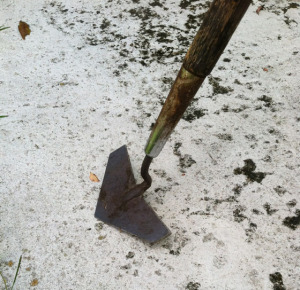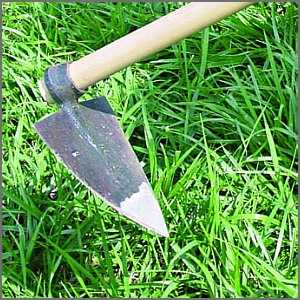 For the survival-minded homesteader – or for those who simply wish to live a simpler existence – good hand tools are important.
For the survival-minded homesteader – or for those who simply wish to live a simpler existence – good hand tools are important.
When you don’t have a tractor or when gas gets too expensive (or disappears), meaning your tiller is dead in the field… it’s good to have solid hand tools that will allow you and your family to keep farming.
We’ve looked at some must-have gardening tools in past posts, as well as included a few extra worthwhile tools such as the broadfork, wheel hoe and the grub hoe.
I recently mentioned to my friend Greg at EasyDigging.com that I thought I had every hoe I needed… though I did wonder
if their pointed hoe (also known as an azada, a triangular hoe or a ridging hoe) might be a good addition for furrowing and trenching. This is an ancient tool used worldwide… I wanted to know if it was worth using in my garden.
In response he mailed me one so I could give it a try.
(Hey, it’s nice having friends in high places.)
When I was a kid, my Dad owned a hoe with a triangular blade. When I picture a triangular hoe, that was always the model I imagined. It had a blade that cut along the ground at a low angle to separate weeds from their roots. Effective, but not quite as efficient as a hula hoe… and the head was rather small for making furrows.
At this point in writing this post… I had an inspiration. Why not call Dad and ask if he still had that hoe? I did, and he does, so I asked him to take a picture… and he did. Thanks, Dad.
Note the completely different angle of the head.
When I received my hoe in the mail it was shipped in two parts: the forged head and a heavy-duty ash handle. The weight of the steel in the head is an impressive 2lbs. That’s a lot of “chop.”
Assembly was simple. There’s a slot at the end of the handle along with a helpful line for aligning the attachement hoop of the triangular blade at the right point on the shaft. Pop the blade on the handle at the right spot, then tap a little metal wedge (included) into the pre-cut slot at the end of handle. Hammer it in, then whack the thing on a concrete slab until it’s nice and tight and voila, it’s hoeing time.
As my first test I took the hoe out to my overgrown potato patch from spring. The tubers were long gone and thick weeds and grass had claimed the plot.
Not for long!
The pointed hoe cut into the ground with very little effort, allowing me to almost drop it into the ground without exerting much swing. I’m sure if I was back working my old rocky clay garden plot in Tennessee it would be a lot more work, but I still think it would prove much easier than digging with a shovel. (Don’t underestimate the additional swing you get with a long handle as opposed to stomping a shovel blade into the ground. I’ve actually taken to planting many plants with my grub hoe since it’s easier than traditional digging.) In Florida sandy loam, the tool is almost effortless.
For furrows it’s also a breeze. The relatively large size of the head makes quick earthmoving easy. Next spring I’ll hopefully be testing it out on some new plots of field corn. (I unfortunately no longer have access to my old field crop test area but I’ve recently made a deal that will keep the Empire out of here forever… I mean… a deal that will give me a spot to keep testing corn and bean varieties.)
For quick hand tilling, this tool excels. It’s easier than the grub hoe though it doesn’t move quite as much earth as a time. It’s also not as good for chopping roots.
If you want a delicate weeding hoe, this isn’t it. But if you need a way to tear through the ground fast (goodbye lawn?), this tool will get you started quickly. It’s also much better made (it AIN’T Chinese!) than anything you’ll find at a local home improvement store and the price is affordable.
If I hadn’t been given one of these to try, say I’d just borrowed a friend’s… afterwards I would have immediately bought one. This is a great tool and well worth adding to your survival garden arsenal.

